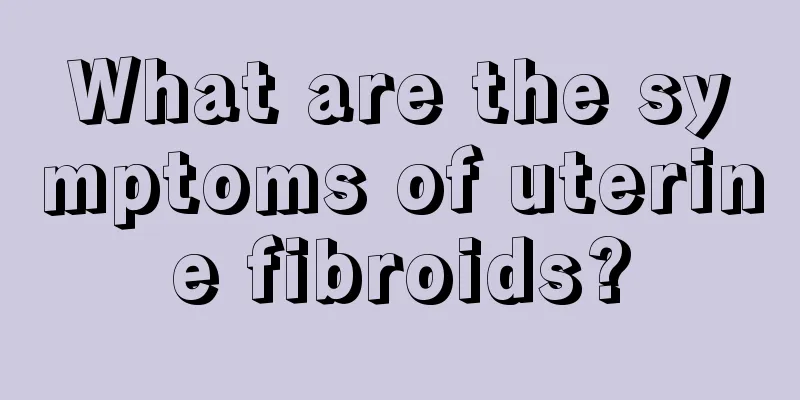What are the symptoms of uterine fibroids?

|
In daily life, no one wants to be sick. Being sick will not only cause great physical pain, but also psychological pressure. In fact, most diseases basically have symptoms in the early stage, but they are likely to be ignored. Uterine fibroids are a common benign tumor. In fact, they also have symptoms in the early stage, but they may be ignored. As a result, the condition worsens before people know they are sick. So what are the symptoms of uterine fibroids? Generally speaking, uterine fibroids may cause the following common symptoms, but each patient may not have all the symptoms, but may only have one or several of them. 1) Vaginal bleeding: This should be the most common symptom of uterine fibroids. Subserosal uterine fibroids located on the outer surface of the uterus usually do not cause vaginal bleeding. When the intramural fibroids are large, they may affect uterine contraction or increase the area of the endometrium, causing excessive menstruation or prolonged menstruation. Submucosal fibroids located in the uterine cavity often cause irregular vaginal bleeding and prolonged menstruation. Of course, there are many reasons for vaginal bleeding. It is important to remind you that if this symptom occurs, do not ignore it by thinking that you are too tired recently or you are in menopause. 2) Pelvic mass: It is often discovered accidentally (such as bathing or sexual intercourse) or during a gynecological examination. When the fibroids are too large or the patient is thin, a hard, solid mass can be felt in the lower abdomen, especially in the morning when the bladder is full before urination. Sometimes you may not be able to feel the tumor, but you will find that your waist circumference has increased. Some middle-aged and elderly people will naturally think that they have gained weight. In remote rural areas with poor medical conditions, or in some people in cities who are reluctant to see a doctor, fibroids may not be discovered until they grow very large. For women of childbearing age, if a pelvic mass is found, the most important thing to consider is not uterine fibroids, but to rule out pregnancy first. This is what textbooks emphasize. 3) Compression symptoms: Uterine fibroids can compress adjacent organs and cause symptoms. Similarly, due to differences in location (growth site) and size, the symptoms produced are also different. Fibroids can compress the bladder forward, causing frequent urination, urgency, or even inability to urinate (called urinary retention). If the fibroids grow on the posterior wall of the uterus, they can compress the rectum backward, causing diarrhea or constipation. Fibroids occurring in the broad ligaments on both sides of the uterus can compress the ureters, internal and external iliac veins, and nerves, causing ureteral obstruction, hydronephrosis, lower limb edema or pain. 4) Infertility: Small fibroids located in the uterine wall or subserosal fibroids generally do not affect pregnancy. However, some fibroids will change the shape of the uterine cavity, or hinder the implantation of the fertilized egg, or grow in the uterine horns, compressing the opening of the fallopian tube into the uterus and preventing the ascending sperm from entering the fallopian tube, all of which can cause infertility. 5) Abdominal pain: Uterine fibroids rarely cause abdominal pain. If the fibroids are too large and compress the pelvic nerves, or if the fibroids undergo red degeneration due to acute ischemia, or if the pedunculated subserosal uterine fibroids twist, it can cause severe abdominal pain. 6) Increased vaginal discharge: more common in submucosal fibroids located in the uterine cavity. When the fibroids prolapse out of the cervix or vaginal opening, their surface will ulcerate and necrotize, and the amount of leucorrhea will increase. If there is an infection, there may be purulent leucorrhea. If the intramural fibroids are large in size, they can increase the area of the uterine cavity, increase endometrial secretion and cause pelvic congestion, and may also cause an increase in leucorrhea. 7) Circulatory system symptoms: Long-term excessive menstruation can cause secondary anemia. Severe anemia may lead to anemic heart disease. |
<<: Will uterine fibroids cause breast pain?
>>: How many days should I wash with potassium permanganate after a normal birth?
Recommend
The saltier you eat, the higher your risk of death! What are the dangers of high-salt food?
Speaking of salt, it is a condiment that everyone...
The most important items in women's physical examination
Everyone hopes to have a healthy body. Whether th...
vivo: Currently, vivo's overseas sales account for more than half of the total revenue and plan to increase it to 70% of the total revenue in 2027
According to recent news, vivo's Chief Operat...
Is baking soda a good treatment for mold?
Baking soda is not only edible, but also can brin...
Can essential oils be used on oily skin? What to do if oily skin absorbs makeup
The biggest characteristic of oily skin is that i...
Taking antihypertensive pills apart can cause coma! Yaowa reminds you: Taking these pills apart is risky!
According to CCTV News, Ms. Zhang from Fujian has...
No leucorrhea before menstruation
Leucorrhea is a normal secretion from the female ...
Is it normal to bleed the next day after a medical abortion?
Medical abortion is a method of abortion through ...
Normal heart rate range for pregnant women
Pregnant women should pay special attention to th...
What to do if you have itchy vagina during confinement
Vaginal itching is often easy to occur after chil...
comScore: Data shows that Americans now spend much more time on apps than on desktop applications
There is no doubt that we now live in a world ful...
How long does it take to have a curettage?
Abortion surgery by curettage and dilatation usua...
What is it like when your age and generation don't match? Why do we call people by their generation when greeting each other during the Chinese New Year?
Many friends go home to pay New Year's greeti...
Can my aunt drink lemon honey?
When women have their periods, they may experienc...
Can I take a shower on the first day of my period?
You can take a shower on the first day of menstru...









